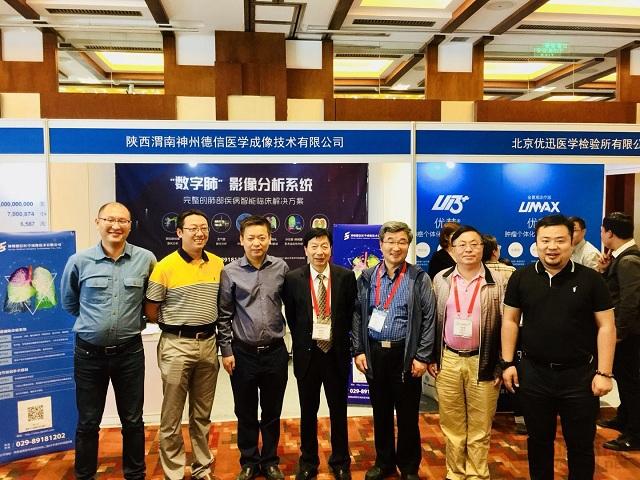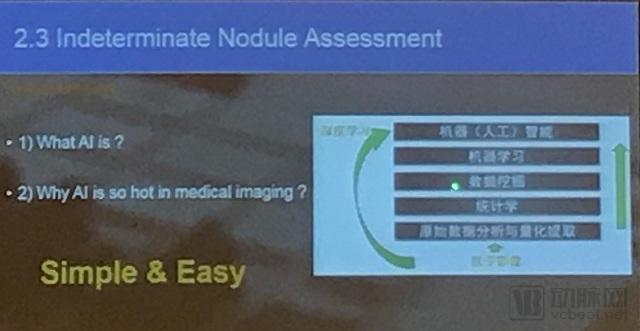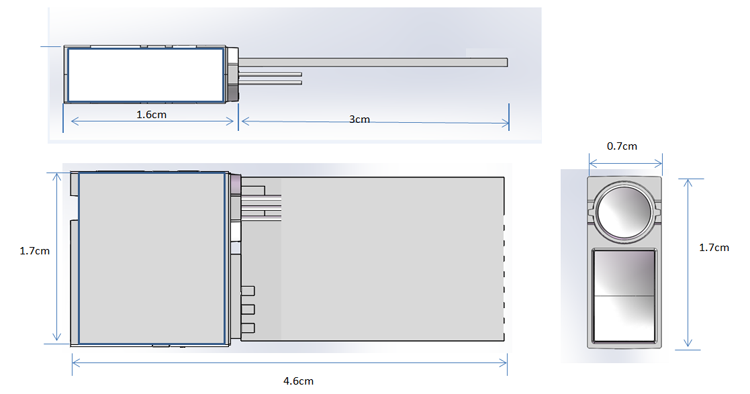Recently, the 2018 National Lung Cancer Academic Conference, co-sponsored by the Chinese Medical Association and the Chinese Medical Association Respiratory Diseases Branch, was held in Beijing. At the meeting, the medical AI company Shenzhou Dexin demonstrated a complete intelligent clinical solution for lung diseases, the “Digital Lung†image analysis system. Wang Yaxuan, general manager of Shenzhou Dexin, said that the “Digital Lung†system provides a complete clinical solution for lung diseases through medical image analysis, and supports accurate quantitative diagnosis of lung tissue, which can improve the efficiency of doctors' reading and effectively assist doctors. Clinical judgment and decision making, reducing errors and improving the success rate of surgery. In addition, Zhao Wei, who is in charge of the work of Shenzhou Dexin Market, told reporters that since the company's “digital lung†system has been certified by CFDA and FDA, in February this year, the PLA General Hospital officially purchased the medical image digital lung diagnosis of Shenzhou Dexin. system. This is an absolute leading position in the medical AI field. Using AI technology to cover multiple links such as diagnosis and treatment, how does Shenzhou Dexin achieve commercialization? To this end, the arterial network has been tracked. Deep plowing for many years in the field of medical AI Founded in 2011, Shenzhou Dexin has been deeply involved in the field of medical artificial intelligence for many years, especially in the field of fundus sugar screening and lung disease assisted diagnosis. The core technical team is technically and in clinical data and communication with clinical experts. Accumulated a lot of experience. Dr. Pu Jiantao, Principal Consultant and Chief Scientist of Dezhou, told the Arterial Network that deep learning technology has not become popular around 2011. In the frontier research field, researchers mainly use image analysis, statistics and traditional machine learning methods. Conduct research and predictive model construction in the field of computer-aided diagnosis. After the establishment of the company, the core technology team of Shenzhou Dexin has made further development in combination with the actual clinical situation in China. The digital lung system, the fundus sugar network assisted screening system, the cardiovascular system and the kidney system have been developed. After 2013, the company's digital lung system was successfully certified by CFDA and FDA, and has the qualification to enter the market. According to the previous certification system and standards, the computer-aided diagnosis system is a second-class certification. With the continuous development of AI technology, deep learning technology began to appear in 2016. As a researcher who has been engaged in cutting-edge research, Professor Pu Jiantao is also using its new technology to continuously improve its own products. Deep learning technology cannot fully represent AI technology Regarding the medical AI industry, many people know that there is not yet a new generation of medical AI products approved, so the products of Shenzhou Dexin are not considered artificial intelligence products, is Shenzhou Dexin not a medical artificial intelligence company? In the face of such doubts, Dr. Pu Jiantao said that first, the industry personnel must first understand the difference between the previous artificial intelligence technology and the popular deep learning technology. In the past, if researchers wanted to develop a medical image-assisted diagnosis system, they needed to quantify and analyze the raw data of medical images, then perform statistical sorting and data mining, and then use machine learning algorithms to train and after repeated polishing. Get an auxiliary diagnostic product model. Now with deep learning technology, the researcher directly skips the intermediate steps, and after the image data is preprocessed, it is directly trained by the deep learning algorithm model, and then the product model is obtained. In many cases, there is no need to have a particularly in-depth understanding of the image, mainly based on the data. The set adjusts key parameters. These two algorithms have their own advantages and disadvantages. The traditional algorithms use less data, but require complex image processing and feature extraction. Deep learning techniques require a large amount of data for training. This amount of data is often in tens of thousands, while traditional algorithms Only hundreds of data is needed. The birth of deep learning technology symbolizes the progress of AI technology. As a technical means, deep learning is a representative technology in the AI ​​field, but it does not fully represent the AI ​​field. No matter which tool the researcher uses, the ultimate goal is to An auxiliary diagnostic system capable of clinical application and effective clinical service was developed. Now most companies in the medical AI industry are working hard with deep learning techniques, and soon they can do it or some companies have already done it. And Shenzhou Dexin did it using machine learning technology five years ago, and it has been certified by CFDA and FDA. In recent years, it has also been using its new technology to continuously polish its products. In the process, it has also been innovated. Other technologies, deep learning is just one of the technical means. In addition, Shenzhou Dexin also used the new AI technology to develop a variety of products such as lung volume reduction surgery planning, preoperative planning of nodular minimally invasive surgery, three-dimensional virtual reality roaming, and pulmonary embolism analysis. Therefore, the industry cannot judge an AI product only by using deep learning technology, nor can it fully represent the AI ​​field with deep learning technology, which is synonymous with AI. Form a complete product structure for assisted diagnosis, treatment, and follow-up Based on its own research achievements accumulated over the years, Shenzhou Dexin has developed a complete product structure covering diagnosis, treatment and follow-up. Wang Yaqing, general manager of Shenzhou Dexin, told the arterial network that the birth of a single product can solve a certain link in medical treatment, but medical care is a chain. The optimization of each link on this chain will solve the medical problem as much as possible. Shenzhou Dexin hopes to provide a complete disease intelligence diagnosis process for hospital departments from the auxiliary diagnosis, treatment and follow-up. At present, China Digital Digital Lung System has launched six intelligent imaging-based auxiliary diagnostic products, namely lung cancer auxiliary diagnosis system, digital lung system, FACT lung volume reduction surgery system, FACT lung function quantification system, FACT lung nodule minimally invasive Surgical system, bronchoscopy. Through the PACS/RIS-based computer-aided diagnosis system, the product can be seamlessly interfaced with imaging equipment and PACS to perform automatic computer detection, segmentation and 3D modeling of various lung and systemic vascular tissues. The system will accurately analyze the abnormalities of the organizational structure and its spatial distribution pattern, and track and change the changes with time, and assist the doctor to make accurate judgments on the patient's disease development and treatment effect, so that the doctor can make The correct standardized treatment plan. At the same time, for the online data processing service of CT images, the system also supports remote batch data transmission, which can automatically process the results and provide feedback to users in time. Zhang Weijie, technical director of Dezhou Dexin, said that the biggest highlight of Shenzhou Dexin's products is that it can quantify the structure of the lungs. Doctors can clearly see the nodules, blood vessels and tissues of the lungs through the three-dimensional images constructed by Shenzhou Dexin. Guide the surgery plan with images visible to the naked eye. The arterial network saw the products of Shenzhou Dexin on the booth, and the marked nodules and capillaries can be clearly seen on the three-dimensional image, just like the lungs are closely copied on the computer. Digital lung was purchased by the PLA General Hospital As the first medical AI company to receive CFDA certification in China, in February this year, the People's Liberation Army General Hospital officially purchased the medical image digital lung diagnosis system of Shenzhou Dexin. Hospital procurement shows that Shenzhou Dexin has the ability to land more than commercialization. In the interview, Professor Zhao Wei, secretary of the Lung Cancer Group of the Chinese Medical Association Respiratory Diseases Branch and deputy director of the Department of Respiratory Medicine of the Chinese People's Liberation Army General Hospital, said: "As a clinical doctor, the starting point for all our tools is clinical needs and research needs. The reason why the product of Shenzhou Dexin was chosen is because the early screening of lung cancer is actually very difficult. The doctor hopes that with the help of tools, it can find abnormalities that are hard to detect by the naked eye. Of course, for experienced doctors, Malignant tumors with clinical features can be found by CT, but very early lung cancer is difficult to find and requires a tool to quantify it and assist doctors in making decisions." Professor Zhao Wei also stressed that in the process of selecting AI products, the department will use the cases with pathological diagnosis to retrospectively verify the products. After comparison, they found that the products of Shenzhou Dexin are still relatively fine, and the products are verified. Generated trust. So choose to purchase their products. The People's Liberation Army General Hospital as a national top three hospital, this purchase also illustrates the product capabilities of Shenzhou Dexin, which has played a benchmark role in opening the market in the future. Zhao Wei said that after this round of financing, the company will vigorously open up the national market and let Our products serve more doctors and patients, and at the same time put considerable effort into the development of next-generation products. IT02S, is JRT new product in the early 2019, which is a single-point LiDAR sensor, also called tof distance sensor. With a micro size of 46x17x7mm, customers can widely use in many Laser Measurement Solutions. The lidar distance sensor can measure 12m short-range with high frequency up to 100hz. It's great for Unmanned Aerial Systems. If you need us send you data sheet and spec for this products, offering sample as well, pls tell us, thank you.
Accuracy
+/-8cm@ 0.1~3.5m
Measuring Unit
cm
Measuring Range (without Reflection)
0.1-12m
Measuring Time
0.1~3 seconds
Measuring Frequency
100 Hz
Laser Class
Class II
Laser Type
650nm, <1mw, red
Weight
About 5g
Voltage
DC2.5V~+3.5V
Serial Level
TTL 3.3V
Size
46*17*7mm
Operating Temperature
0-40 ℃ (32-104 ℉ )
Storage Temperature
-25~60 ℃ (-13~140 ℉)
2D Laser Distance Sensor,2D Lidar Sensors,Tof Lidar Distance Sensor, Flight Distance Sensor Chengdu JRT Meter Technology Co., Ltd , https://www.jrt-measure.com

IT02S Mini Tof Sensor Module Diagram

Parameters of IT02S:
IT02S – the High performance-price ratio measurement solution
* low power consumption of single transmit and single receive
* small size: 46*17*7mm
* low cost
* proffessional techinical support